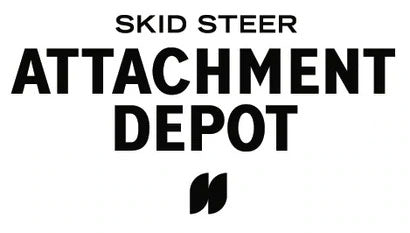Skid Steer Attachment Maintenance
You love your skid steer. It's versatile, dependable, and makes quick work of nearly any project in your farm or landscape business. But like any machine, it requires regular maintenance to keep it running strong. The same is true of your skid steer attachments.
Whether your skid steer's primary use is for business or personal projects, every minute a skid steer attachment spends in disrepair is another minute of lost profitability or productivity. A few simple maintenance steps will help you keep your attachments in good working order and make the most of your investment!
Maintain Your Equipment and Keep it Functioning Properly
By taking the time to care for your attachments, you can prolong their lives, prevent potential issues, and avoid unexpected downtime. Attachment maintenance doesn't need to be time-consuming and tedious – that's where we come in.

Here is a comprehensive list of tips and steps for maintaining skid steer attachments so you can keep your equipment running like new:
1. Read Your Skid Steer Attachment Manual
Before you start putting your new attachment to work, you need to read the manual. No, it may not be the most exciting way to spend an afternoon, but taking the time to familiarize yourself with your attachment's operations and maintenance requirements can save you a lot of headaches down the road. Plus, it'll help you refer to the manual more quickly if you have issues later on.
2. Inspect the Skid Steer Attachment Before Each Use
Before you start up your skid steer loader for the day, take a moment to give your attachment a once-over. Those few minutes you spend doing a thorough inspection could save you hours of downtime if a problem actually occurred while on the job.
Here's what you should look for:
- Check for wear and tear, such as cracked hydraulic hoses and loose bolts, cap screws, or fittings.
- For bladed attachments, inspect your attachment's cutting edge (tooth or blade) to ensure that it is sharp and in good condition.
- For chain-driven attachments, check the chain tension.
- Ensure all safety shields are secure.
A quick inspection can go a long way towards ensuring your skid steer attachment is ready (and stays ready) to tackle whatever you throw its way.
3. Clean the Attachment After Use
Dirt and debris can build up over time and cause wear and tear on the attachment, so it's important to clean it regularly. A quick once-over with a power washer or hose will help to keep your attachment in top condition and prevent long-term damage. Additionally, it can be easy to overlook an attachment problem if it's covered in dirt.
4. Lubricate All Moving Parts of the Attachment
Grease your attachments regularly and liberally to prevent corrosion and keep moving parts functioning properly. Depending on the attachment, you will use different types of grease, so it's important to get familiar with what works best.
5. Disconnect the Attachment from the Skid Steer and Store it in a Safe Place When Not in Use
One important aspect of attachment maintenance is disconnecting the attachment from the skid steer when it's not in use. This prevents accidental damage and wear and tear from the elements and helps keep the attachment in good working condition.
What's the Best Way to Store Skid Steer Attachments When Not in Use?
Like most skid steer owners, you probably don't use all of your attachments daily. Here are a few tips for proper attachment storage:
- If possible, store your attachments indoors in a climate-controlled environment. A cool and dry space will help to protect them from the elements and extend their lifespan.
- Make sure that any high-powered attachments (such as brush mulchers or cold planers) are properly drained of any fluids before storing them. Otherwise, they could rust or corrode while they're sitting idle.
- Get organized. If possible, find a storage container or rack big enough for all your attachments to make it easy to find everything when needed.
- Invest in some attachment covers. Especially if you must store your attachments outdoors, cover them with a tarp or similar material to keep them clean and dry.
- Consult your owner's manual for storage instructions for your particular model of skid steer attachment. Didn't think you'd get away without hearing about the manual again, did you?
From regular cleaning to inspecting for wear and tear, we've covered everything you need to know to extend the life of your attachments. So next time you're about to tackle a project, take a few minutes to inspect your skid steer attachment first. It's a small investment of time that could save you a big investment in repairs or replacements.





